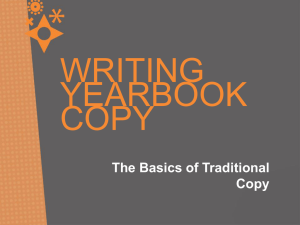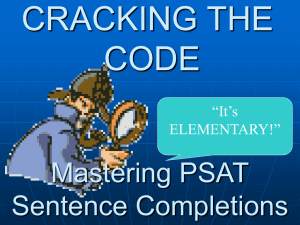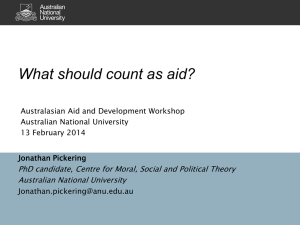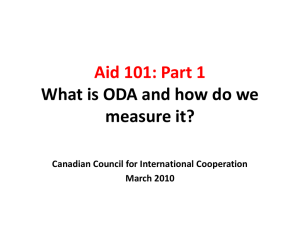Policy Advocacy
advertisement
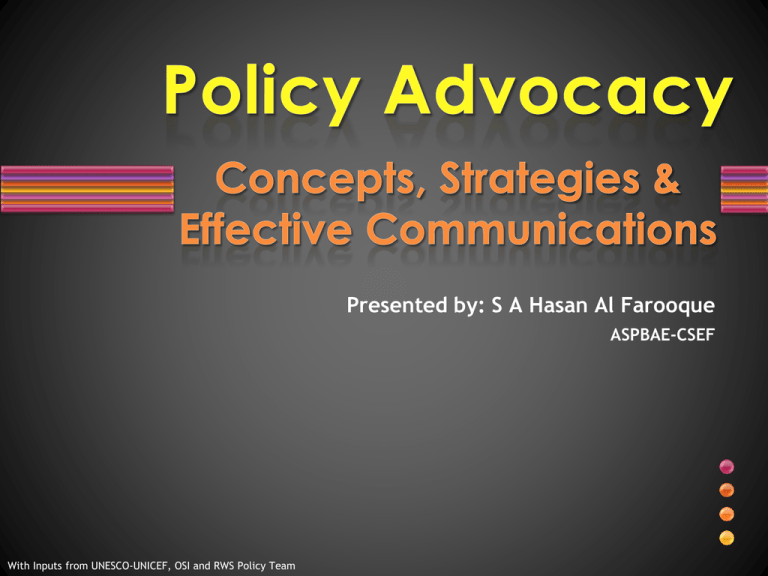
Presented by: S A Hasan Al Farooque ASPBAE-CSEF With Inputs from UNESCO-UNICEF, OSI and RWS Policy Team • Policy is a set of principles that represent the end result of a decision as to how best to achieve the set objectives • It is the function of POLITICS • Politics is the function of ARTS and SCIENCE of power Ideology How we conceptualise Strategy How do we do • Policy Advocacy is a strategy to – Build evidence based on analysis – Engage with development planning and policy debates – Influence policy makers, policy agencies and policy agenda With a view to create, reform and/or change policies, and to ensure that the policies are implemented properly • Policy advocacy is a coordinated effort to achieve meaningful change – for real education reform, it is important to ensure coordination among: – the right institutions; and – sensitized and mobilised citizenry (this includes, but is not limited to, organized civil society – NGOs, CSOs, CBOs etc.) Identify a policy issue - Set a policy goal - Desired outcomes - Define the target Analyse policies Plan for monitoring and evaluation Essential Steps Identify key messages Plan of implementation Define the strategy Identify key partners/allies • Be Analytical: Undertake research and understand what the data and information reflect – What story are they telling you and where the gaps lie? • Find a position: Identify what needs to be changed (politically, economically, culturally) to fix the situation. • Stay focused: Make sure to follow a process where your communication and advocacy actions are mutually supportive to the changes required. • Be Strategic: The next phase is about delineating strategies to address the challenges identified. So comes the how part.... • Develop a policy statement • Identify your audiences and allies • Develop your SMART objectives (specific, measurable, appropriate, realistic and time-bound) • Engage/coordinate/ ensure linkage among partners and allies to – Mobilise the stakeholders (awareness & capacity development and ongoing actions based on ownership) – Lobby with the relevant counterparts/ audiences/ government through consultations/ briefings • Involve Media at all stage • Continue wider communication, dissemination & knowledge management (publications, case studies, information communication materials, websites, e-mail etc.) • Technical expertise in advocacy and campaigning for effective communication at all levels and stages • Knowledge and expertise on the issue being addressed to hold the authorities accountable • Political expertise on the relations of power that affect the issue (the key target) • An ongoing process – Establish a regular process of understanding emerging policy issues based on research and analysis and sharing of information – Periodically review & document changes and successes and accordingly plan revised actions based on shared learning – Establish means to keep all actors and audiences informed on the progress, results, learning, challenges and the changes Tip # 1: Define your goal • A clearly defined goal, is essential for developing a clear, concise and compelling message. • Defining the goal also includes understanding the achievability & identifying resource requirements. • Think SMART (specific, measurable, appropriate, realistic and time-bound). • Know your political environment. Look for opportunities (hooks). – Meetings and Summits of ADB, WB-IMF, ASEAN – Budget hearings at the national level – GAW, Post-CONFINTEA VI meetings, etc • Ultimate end goal: We need change in ODA Policies! Tip # 2: Identify your target. • It is critical to Know and Understand Your Audience & Your Target. Your goal will help determine your audience. – Donors, MOE, IFIs, MoF etc – General People/ citizenry • Understand your audience - identify what motivates them and what may hold them back from supporting your goal. • Understand the best way to reach your audience. Tip # 3: Make your audience act. • Present possible & doable solutions. Think SMART. “Never go outside the expertise of your people….. whenever possible, go outside the expertise of the enemy.” – Saul Alinsky – Advocates and the Public Engage them in awareness raising activities, lobbying and mobilisation – Policy Makers engage them through consultations, dialogue ask them to read your policy paper Tip # 4: Keep it simple & brief. • It is important to be very concise in your message. Keep it simple. Use precise language, powerful words and active verbs. • Attract attention. Eg. One ODA statistic US$ 16B per year resource gap for educationwill do at the moment. Tip # 5: Be persuasive. Combine the rational and emotional. • Present evidence. Many people believe something only when they see proof in the form of facts. Others need to believe in something before they acknowledge the facts. – Use real life stories. Dramatization of facts more often than not appeals more to audience. • Your messages need to be balanced to capture both hearts and thoughts. • Use facts and numbers creatively, but accurately. – Don’t let wrong data and numbers ruin your plan Tip # 6: Determine the primary message. • This is the one message that is clear, concise and compelling and appeals to the broadest audience. • Adapt the message to the medium. Tip # 7: Create secondary messages for each of your audiences • Prioritise your secondary messages according to the priorities of your target audience. Tip # 8: Write and share the message. • Simplify the message into talking points that every advocate (individual and group) can use. Tip # 9: Do not use jargon in your messages • Speak to people in their language not yours. • Do not assume everyone knows the meaning of your acronyms! Jargon vs Development Speak Situation: To properly implement this dance of Latin American derivation requires the simultaneous participation of both stakeholders. Situation: It is crucial to make sure that the end result of a farm animal reproduction project is not assumed in advance of proper tabulations being conducted. This ensures that results are conclusive and confirmed by all partners. Tip # 10: Know the language of your audience. • Language should be used appropriately to appeal to different targets. In talks with – With policy makers/decision makers/experts - know and express concepts and terminology clearly and effectively. – Public – simplify and use select jargon smartly and often to familiarize the general audience. Eg. Simple fact sheet - ODA 101 - for public use Jargon vs DevelopmentSpeak Situation: Official Development Assistance for which the associated goods and services may be fully and freely procured. Jargon vs DevelopmentSpeak Situation: Transfers made in cash, goods or services for which no repayment is required Having these tips in mind…



